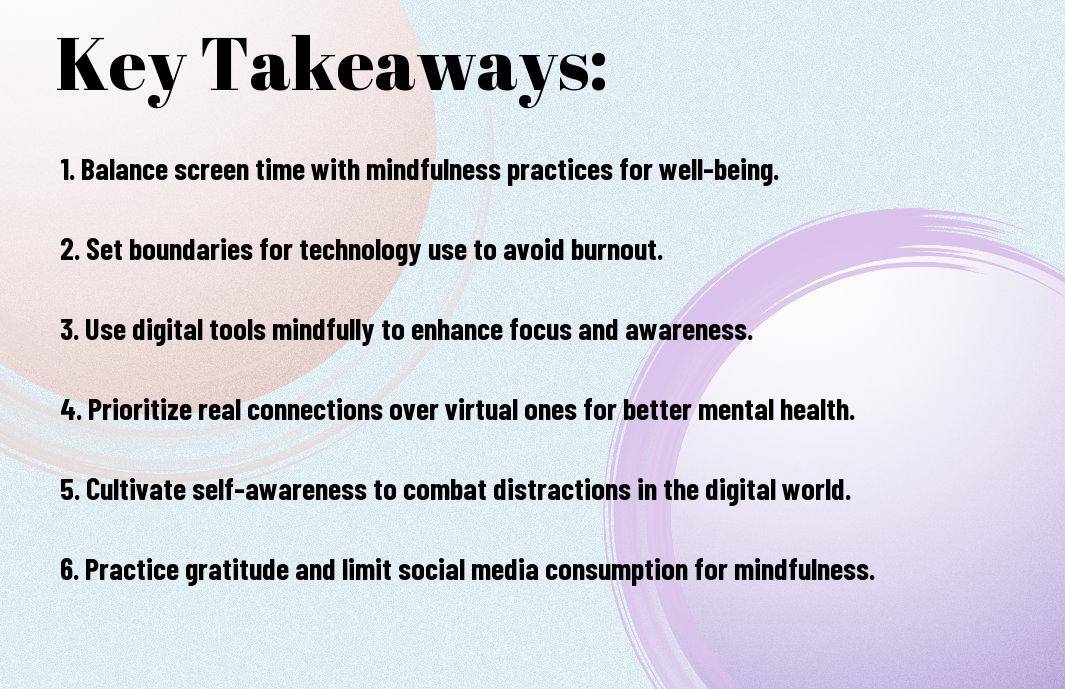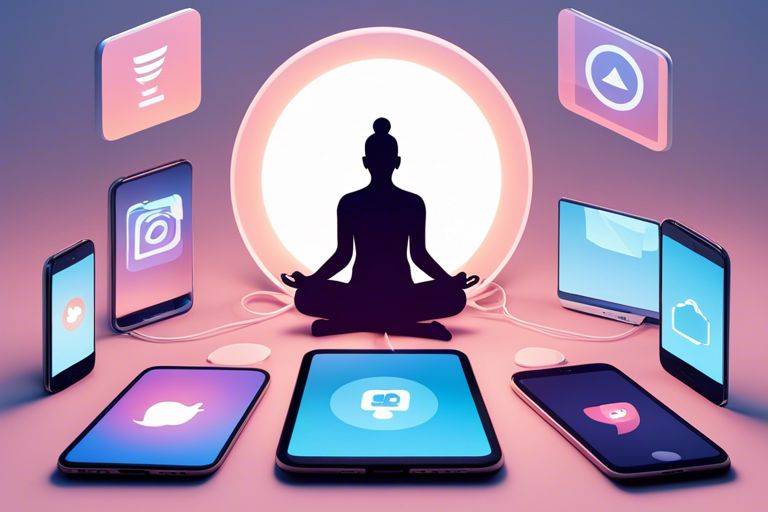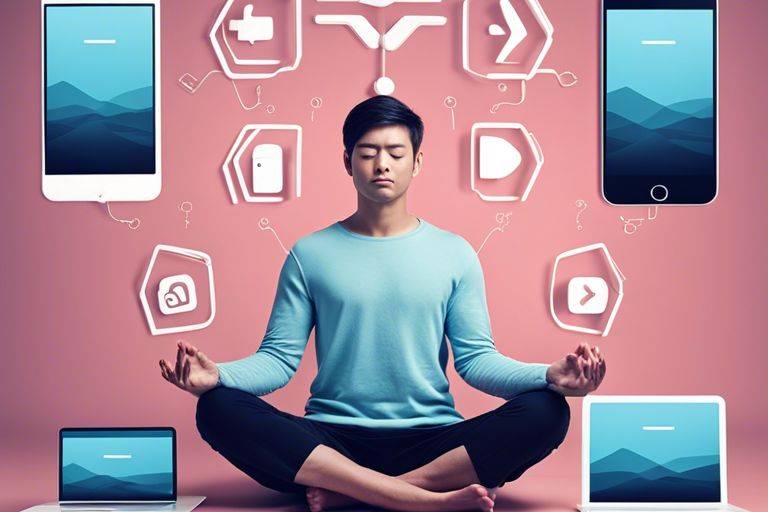Mindfulness in the Digital Age! With the constant bombardment of notifications, distractions, and information overload in the digital age, it has become increasingly challenging to maintain a state of mindfulness. The prevalence of social media, online news, and digital devices has made it difficult for individuals to stay present and focused on the moment. However, by incorporating techniques and strategies for navigating mindfulness in the digital age, it is possible to find more balance and peace in our everyday lives.
Key Takeaways:
- Mindful Technology Use: It is vital to be aware of how we interact with technology to maintain mindfulness in the digital age.
- Set Boundaries: Establish clear boundaries for technology use to prevent distractions and maintain focus on the present moment.
- Practice Digital Detox: Regularly disconnecting from digital devices can help reduce stress, improve well-being, and enhance mindfulness.
- Cultivate Presence: Engage in mindfulness practices such as meditation and deep breathing to stay present and grounded in the midst of digital distractions.
- Balance Screen Time: Strive for a healthy balance between screen time and off-screen activities to promote overall well-being and mindfulness.
- Limit Multitasking: Focus on one task at a time to enhance efficiency, productivity, and mindfulness in the digital age.
- Embrace Mindful Technology Tools: Use apps and tools designed to support mindfulness, such as meditation apps and digital well-being features, to enhance your digital experience.

Understanding Mindfulness
You, in your quest to navigate mindfulness in the digital age, must first understand the essence of mindfulness itself. At its core, mindfulness is the practice of being present and fully engaged in the moment, without judgment or attachment to the past or future. It involves paying attention to your thoughts, feelings, bodily sensations, and the surrounding environment with a sense of curiosity and acceptance.
Historical Roots and Evolution
One can trace the roots of mindfulness back to ancient contemplative practices in Hinduism and Buddhism, where it was a key element in spiritual development. Over the centuries, mindfulness techniques have evolved and been adapted in various cultural and religious contexts, eventually making their way into secular settings as well. In recent years, there has been a surge of interest in mindfulness in the West, as scientific research has highlighted its benefits for mental health and well-being.
Core Principles and Practices
Core to mindfulness are principles such as non-judgment, acceptance, and heightened awareness. By cultivating these qualities through practices like meditation, yoga, or breathwork, individuals can develop a greater sense of self-awareness and emotional regulation. Research has shown that regular mindfulness practice can lead to reduced stress, improved focus, and better overall mood.
To research deeper into the core principles and practices of mindfulness, it is crucial to commit to regular practice and cultivate a mindset of openness and curiosity. By developing a daily mindfulness routine that works for you, you can start to experience the transformative power of living in the present moment.

The Digital Landscape
For many of us, the digital landscape has become an integral part of our daily lives. From smartphones to social media platforms, our connection to the digital world is pervasive. Navigating this landscape mindfully is imperative in the digital age to maintain our well-being and mental health.
The Rise of Technology and Social Media
Rise As technology continues to advance at an unprecedented pace, the rise of social media has transformed the way we communicate, connect, and consume information. Platforms like Facebook, Instagram, and Twitter have become ingrained in our social fabric, shaping how we perceive ourselves and others. The immediacy and constant connectivity offered by these platforms have reshaped social dynamics and brought both opportunities and challenges.
Impacts of Digital Consumption on Mental Health
Mental The surge in digital consumption has had a profound impact on mental health. Studies have shown a correlation between excessive social media use and feelings of loneliness, depression, and anxiety. The never-ending stream of curated content and online interactions can create a sense of inadequacy and unrealistic comparison, leading to negative effects on self-esteem and overall well-being.
Digital It’s crucial to be aware of the potential dangers of overindulgence in digital consumption. Setting boundaries, taking regular breaks, and engaging in activities that promote offline connections and self-care are key in mitigating the adverse effects of excessive digital consumption on mental health.
Mindfulness Techniques and Digital Tools
All Mindfulness in the Digital Age – Bootcamp – UX Collective, a the surge in digital technology has both facilitated and complicated the practice of mindfulness. Fortunately, there are numerous digital tools available to help integrate mindfulness into our daily lives. These tools can range from apps that guide meditation and breathing exercises to online resources that offer mindfulness courses and educational materials.
Apps and Online Resources for Mindfulness
Mindfulness apps such as Headspace, Calm, and Insight Timer provide convenient access to guided meditation sessions and mindfulness exercises. These apps can be easily downloaded to smartphones and tablets, allowing users to practice mindfulness anytime, anywhere. Online resources like Mindful.org and UCSD Center for Mindfulness offer articles, videos, and courses to deepen one’s understanding of mindfulness and incorporate it into different aspects of life. The accessibility of these digital resources makes it easier for individuals to prioritize their mental well-being and cultivate a regular mindfulness practice.
Integrating Mindfulness with Wearable Technology
The integration of mindfulness with wearable technology has opened up new possibilities for monitoring and improving mental well-being. Wearable devices such as smartwatches and fitness trackers can now track metrics like heart rate variability and stress levels, providing users with real-time feedback on their emotional state. This data can help individuals identify patterns and triggers that may affect their mindfulness practice and overall health. By leveraging wearable technology, users can gain valuable insights and take proactive steps to enhance their mindfulness journey.
Mindfulness in Everyday Digital Interactions
Many Mindfulness in the Digital Age: Navigating the Benefits and Challenges individuals find themselves constantly connected through digital means, whether through messaging apps or social media platforms. As we navigate the digital landscape, practicing mindfulness becomes necessary in ensuring that our online interactions are meaningful and positive.
Mindful Communication in the World of Instant Messaging
Digital communication through instant messaging has become ubiquitous in our daily lives. It’s important to bring awareness to how we engage in these conversations to ensure they are meaningful and respectful. Mindfulness in instant messaging can involve actively listening to the person you are chatting with, being present in the conversation, and refraining from judgment or assumptions.
The Role of Mindfulness in Navigating Social Media
To navigate the world of social media mindfully, it’s crucial to be conscious of how we consume and interact with content. Awareness of our emotions and reactions while scrolling through social media feeds can help us make conscious choices about what content to engage with and how to respond. By practicing mindfulness on social media, we can cultivate a more positive digital experience and protect our mental well-being.
The exploration of mindful interactions in the digital age offers individuals the opportunity to shape their online presence with intention and authenticity. By incorporating mindfulness into everyday digital interactions, we can foster meaningful connections and contribute positively to the digital community.
Overcoming Digital Distractions
Despite the numerous benefits that technology provides, the digital age also comes with its fair share of distractions that can hinder our mindfulness and overall well-being. From constant notifications to endless scrolling, it’s easy to get caught up in the digital world and lose focus on the present moment.
Identifying Digital Distractions and Their Sources
An crucial step in overcoming digital distractions is to identify them and their sources. Common digital distractions include social media, email notifications, app alerts, and online shopping temptations. These distractions can lead to reduced productivity, increased stress levels, and a sense of being disconnected from reality.
Strategies for Minimizing Digital Interruptions
An effective way to minimize digital interruptions is to set boundaries with technology use. This can include turning off notifications during certain times of the day, designating specific periods for checking emails and messages, and creating tech-free zones in your home or workplace. Additionally, practicing digital detoxes where you disconnect from all devices for a set period can help reset your focus and reduce dependency on technology.
Plus, incorporating mindfulness practices such as meditation and deep breathing exercises can help enhance your awareness of digital distractions and improve your ability to stay present amidst the digital noise. By consciously choosing when and how to engage with technology, you can regain control over your attention and cultivate a more mindful relationship with the digital world.

Building a Mindful Digital Environment
Notably, mindfulness in the digital age is necessary to our well-being and productivity. As we navigate the ever-evolving digital landscape, it’s crucial to establish a mindful digital environment that promotes balance and focus.
Creating Boundaries with Technology
Mindful use of technology begins with setting clear boundaries. Allocate specific times for checking emails and social media to avoid constant distractions. Consider implementing “tech-free” zones in your home or office to foster undisturbed time for relaxation and face-to-face interactions. By establishing boundaries, you can reduce digital overwhelm and create space for mindfulness in your daily routines.
Cultivating Mindfulness in Digital Workspaces
To cultivate mindfulness in digital workspaces, it’s necessary to integrate moments of reflection and presence throughout your day. Utilize mindfulness apps or plugins that promote relaxation and focus during work breaks. Additionally, practice the 20-20-20 rule – every 20 minutes, look at something 20 feet away for 20 seconds to reduce eye strain and promote mindfulness. By incorporating these practices into your digital workspace, you can enhance productivity and well-being.
The Future of Mindfulness and Technology
Once again, we find ourselves at the intersection of mindfulness and technology, witnessing the evolving landscape of how we engage with our digital devices and the impact it has on our well-being. As technology continues to advance at a rapid pace, the future of mindfulness in the digital age takes on a new level of significance.
Emerging Trends in Mindfulness and Tech Innovations
Any discussion about the future of mindfulness and technology must explore the emerging trends that are shaping this space. From wearable devices that track our biometric data to meditation apps that guide us through mindfulness practices, the integration of technology into our mindfulness routines is becoming more seamless and personalized. As artificial intelligence and virtual reality technologies continue to develop, the possibilities for enhancing our mindfulness experiences are expanding exponentially.
The Potential for a More Mindful Digital Society
Any envisioning of the future of mindfulness and technology must consider the potential for a more mindful digital society. As we navigate the complexities of an increasingly digital world, there is a growing awareness of the need to strike a balance between our online and offline lives. By leveraging technology to promote well-being, foster human connection, and cultivate mindfulness practices, we have the opportunity to shape a digital landscape that supports our mental health and overall quality of life.
Understanding the importance of incorporating mindfulness practices into our digital experiences is crucial for promoting mental well-being in an age where technology is pervasive. By harnessing the power of technology to facilitate mindful habits and cultivate digital mindfulness, we can create a more harmonious relationship with our digital devices and pave the way for a healthier and more mindful future.
Summing up
With these considerations in mind, it is evident that navigating mindfulness in the digital age requires a conscious effort to balance the benefits and challenges that technology brings to our daily lives. By practicing self-awareness, setting boundaries with digital devices, and incorporating mindfulness techniques into our routine, we can cultivate a healthier relationship with technology and safeguard our mental well-being. For more tips on how to integrate mindfulness into your digital lifestyle, check out Navigating The Digital Age With Mindfulness | Lifehack.
FAQ
Q: What is mindfulness?
A: Mindfulness is the practice of being fully present and aware of one’s thoughts, feelings, sensations, and surroundings without judgment.
Q: Why is mindfulness important in the digital age?
A: Mindfulness is crucial in the digital age because it helps individuals manage stress, improve focus, enhance relationships, and cope with the constant influx of information from digital devices.
Q: How can digital devices affect our mindfulness?
A: Digital devices can lead to distractions, decreased attention spans, increased stress levels, and reduced face-to-face interactions, all of which can hinder our ability to be mindful.
Q: What are some tips for practicing mindfulness in the digital age?
A: Some tips include setting boundaries with technology, taking digital detox breaks, practicing mindful breathing exercises, and engaging in activities that promote presence and awareness.
Q: Can technology help us become more mindful?
A: Yes, there are numerous mindfulness apps, wearable devices, and online resources that can assist individuals in developing a mindfulness practice and integrating it into their daily lives.
Q: How can mindfulness benefit our mental and emotional well-being in the digital age?
A: Mindfulness can help reduce anxiety, depression, and stress, improve focus and attention, enhance self-awareness, and cultivate empathy and compassion towards oneself and others.
Q: What are some common misconceptions about mindfulness in the digital age?
A: Some common misconceptions include thinking that mindfulness is only about relaxation, meditation is the only way to practice mindfulness, and that technology is always detrimental to our mindfulness practice.
Dive Deeper Into Ideas
The Science of Concentration in The Art of Focus
The secret to happiness according to Ken Honda


